Subjective Perception and Cooling Effect for Dynamic Ventilation with Fluctuating Air Velocity
Abstract
1. Introduction
- (i)
- A controlled and consistent experimental environment is established for all participants, within which both subjective evaluations and objective measurements are conducted under dynamic ventilation and steady ventilation;
- (ii)
- A comprehensive comparative analysis is performed between subjective questionnaire responses and physiological indicators, thereby validating the reliability and accuracy of subjective thermal comfort assessments;
- (iii)
- The implementation of dynamic ventilation demonstrates a significant improvement in participants’ thermal comfort satisfaction and a notable reduction in draft risk.
2. Methodology
2.1. Measurement Site
2.2. Subjective Questionnaire
2.3. Physiological Parameters
3. Results
3.1. Spatial Transmission Characteristics of Airflow
3.2. Analysis of Subjective Surveys
4. Discussion
5. Future Studies
6. Conclusions
- (1)
- Dynamic ventilation is capable of maintaining the participants in a thermally neutral environment, which further reduces thermal sensation votes for the upper arm, forearm, and hand to −0.1, −0.4, and −0.3, respectively.
- (2)
- The intensified convective heat exchange coupled with the rhythmic stimulation of cutaneous cold receptors generates a stronger and more sustained cooling effect, which in turn results in a noticeable reduction in skin temperature under dynamic ventilation.
- (3)
- Dynamic ventilation completely eliminates draft-related dissatisfaction, with the draft rate decreasing from 10% under steady ventilation to 0% under dynamic ventilation.
Author Contributions
Funding
Data Availability Statement
Conflicts of Interest
Appendix A
| Body Part | Cold | Cool | Slightly Cool | Neutral | Slightly Warm | Warm | Hot |
| Forehead | □ | □ | □ | □ | □ | □ | □ |
| Chest | □ | □ | □ | □ | □ | □ | □ |
| Back | □ | □ | □ | □ | □ | □ | □ |
| Upper arm | □ | □ | □ | □ | □ | □ | □ |
| Forearm | □ | □ | □ | □ | □ | □ | □ |
| Hand | □ | □ | □ | □ | □ | □ | □ |
| Thigh | □ | □ | □ | □ | □ | □ | □ |
| Calf | □ | □ | □ | □ | □ | □ | □ |
| Foot | □ | □ | □ | □ | □ | □ | □ |
References
- Shahzad, S.; Calautit, J.K.; Aquino, A.I.; Nasir, D.S.; Hughes, B.R. Neutral thermal sensation or dynamic thermal comfort? Numerical and field test analysis of a thermal chair. Energy Procedia 2017, 142, 2189–2194. [Google Scholar] [CrossRef]
- Tian, X.; Lin, Z. Dynamic modelling of air temperature in breathing zone with stratum ventilation using a pulsating air supply. Build. Environ. 2022, 210, 108697. [Google Scholar] [CrossRef]
- Hua, J.; Ouyang, Q.; Wang, Y.; Li, H.; Zhu, Y. A dynamic air supply device used to produce simulated natural wind in an indoor environment. Build. Environ. 2012, 47, 349–356. [Google Scholar] [CrossRef]
- Huang, L.; Ouyang, Q.; Zhu, Y. Perceptible airflow fluctuation frequency and human thermal response. Build. Environ. 2012, 54, 14–19. [Google Scholar] [CrossRef]
- Li, J.; Zhou, S.; Yu, Y.; Niu, J. Effects of dynamic airflows on convective cooling of human bodies− Advances in thermal comfort assessment and engineering design. Energy Build. 2024, 324, 114924. [Google Scholar] [CrossRef]
- Zhao, H.; Ji, W.; Deng, S.; Wang, Z.; Liu, S. A review of dynamic thermal comfort influenced by environmental parameters and human factors. Energy Build. 2024, 318, 114467. [Google Scholar] [CrossRef]
- Yang, B.; Melikov, A.K.; Kabanshi, A.; Zhang, C.; Bauman, F.S.; Cao, G.; Awbi, H.; Wigö, H.; Niu, J.; Cheong, K.W.D. A review of advanced air distribution methods-theory, practice, limitations and solutions. Energy Build. 2019, 202, 109359. [Google Scholar] [CrossRef]
- Tian, X.; Zhang, S.; Lin, Z.; Li, Y.; Cheng, Y.; Liao, C. Experimental investigation of thermal comfort with stratum ventilation using a pulsating air supply. Build. Environ. 2019, 165, 106416. [Google Scholar] [CrossRef]
- Schlader, Z.J.; Simmons, S.E.; Stannard, S.R.; Mündel, T. The independent roles of temperature and thermal perception in the control of human thermoregulatory behavior. Physiol. Behav. 2011, 103, 217–224. [Google Scholar] [CrossRef] [PubMed]
- Zhu, Y.; Luo, M.; Ouyang, Q.; Huang, L.; Cao, B. Dynamic characteristics and comfort assessment of airflows in indoor environments: A review. Build. Environ. 2015, 91, 5–14. [Google Scholar] [CrossRef]
- Zhou, S.; Yu, Y.; Kwok, K.C.; Niu, J. Onsite measurements of pedestrian-level wind and preliminary assessment of effects of turbulence characteristics on human body convective heat transfer. Energy Build. 2024, 318, 114448. [Google Scholar] [CrossRef]
- Zhou, X.; Ouyang, Q.; Lin, G.; Zhu, Y. Impact of dynamic airflow on human thermal response. Indoor Air 2006, 16, 348–355. [Google Scholar] [CrossRef]
- Li, Z.; Zhou, B.; Yang, B.; Li, H.; Jin, D.; Wang, F. Occupant thermal and draft perceptions under various intermittent regimes of an intermittent air jet strategy. Build. Environ. 2024, 262, 111839. [Google Scholar] [CrossRef]
- Ren, G.; Liu, J.; Wan, J.; Li, F.; Guo, Y.; Yu, D. The analysis of turbulence intensity based on wind speed data in onshore wind farms. Renew. Energy 2018, 123, 756–766. [Google Scholar] [CrossRef]
- Du, C.; Liu, H.; Yu, W.; Ji, Y.; Yan, K.; Ruan, L. Characteristics and comfort evaluation of sinusoidal airflows by regulating motor rotating frequency of a floor fan. Build. Simul. 2022, 15, 1035–1049. [Google Scholar] [CrossRef]
- Wang, K.; Xie, Z.; Xiao, Y.; Zhou, X.; Luo, M. Spatial Distribution of Dynamic Characteristics of Fan Airflows and Their Impact on Thermal Comfort. Buildings 2025, 15, 308. [Google Scholar] [CrossRef]
- Zhou, B.; Li, Z.; Yang, B.; Li, X.; Wang, F.; Wei, S. Thermal and draught perception in fluctuating stratified thermal environments with intermittent impinging jet ventilation. Build. Environ. 2023, 229, 109934. [Google Scholar] [CrossRef]
- Faul, F.; Erdfelder, E.; Buchner, A.; Lang, A.-G. Statistical power analyses using G* Power 3.1: Tests for correlation and regression analyses. Behav. Res. Methods 2009, 41, 1149–1160. [Google Scholar] [CrossRef]
- Faul, F.; Erdfelder, E.; Lang, A.-G.; Buchner, A. G* Power 3: A flexible statistical power analysis program for the social, behavioral, and biomedical sciences. Behav. Res. Methods 2007, 39, 175–191. [Google Scholar] [CrossRef]
- Pan, J.; Li, N.; Zhang, W.; He, Y.; Hu, X. Investigation based on physiological parameters of human thermal sensation and comfort zone on indoor solar radiation conditions in summer. Build. Environ. 2022, 226, 109780. [Google Scholar] [CrossRef]
- Zhang, S.; Jiang, J.; Lin, Z. Time length of adaptation phase for subjective thermal environment evaluation based on thermal stability time. Build. Environ. 2025, 267, 112283. [Google Scholar] [CrossRef]
- ANSI/ASHRAE Standard 55-2023; Thermal Environmental Conditions for Human Occupancy. ASHRAE: Atlanta, GA, USA, 2023.
- Saiko, G. Skin temperature: The impact of perfusion, epidermis thickness, and skin wetness. Appl. Sci. 2022, 12, 7106. [Google Scholar] [CrossRef]
- Luo, M.; Ji, W.; Cao, B.; Ouyang, Q.; Zhu, Y. Indoor climate and thermal physiological adaptation: Evidences from migrants with different cold indoor exposures. Build. Environ. 2016, 98, 30–38. [Google Scholar] [CrossRef]
- Liu, W.; Lian, Z.; Deng, Q. Use of mean skin temperature in evaluation of individual thermal comfort for a person in a sleeping posture under steady thermal environment. Indoor Built Environ. 2015, 24, 489–499. [Google Scholar] [CrossRef]
- Liu, W.; Lian, Z.; Deng, Q.; Liu, Y. Evaluation of calculation methods of mean skin temperature for use in thermal comfort study. Build. Environ. 2011, 46, 478–488. [Google Scholar] [CrossRef]
- Wigö, H. Technique and Human Perception of Intermittent Air Velocity Variation; KTH Royal Institute of Technology: Stockholm, Sweden, 2005. [Google Scholar]
- Tian, X.; Li, B.; Cheng, Y. Experimental study into turbulent characteristics of airflows under stratum ventilation with pulsating air supply: Comparison to steady air supply. IOP Conf. Ser. Earth Environ. Sci. 2019, 295, 042078. [Google Scholar] [CrossRef]
- Tian, X.; Li, B.; Liao, C.; Cheng, Y. Experimental comparison on dynamic characteristics of the airflows produced by pulsating and steady air supply under stratum ventilation. IOP Conf. Ser. Mater. Sci. Eng. 2019, 609, 032020. [Google Scholar] [CrossRef]
- Uğursal, A.; Culp, C.H. The effect of temperature, metabolic rate and dynamic localized airflow on thermal comfort. Appl. Energy 2013, 111, 64–73. [Google Scholar] [CrossRef]
- Parkinson, T.; Zhang, H.; Arens, E.; He, Y.; de Dear, R.; Elson, J.; Parkinson, A.; Maranville, C.; Wang, A. Predicting thermal pleasure experienced in dynamic environments from simulated cutaneous thermoreceptor activity. Indoor Air 2021, 31, 2266–2280. [Google Scholar] [CrossRef]
- Buonocore, C.; De Vecchi, R.; Lamberts, R.; Güths, S. From characterisation to evaluation: A review of dynamic and non-uniform airflows in thermal comfort studies. Build. Environ. 2021, 206, 108386. [Google Scholar] [CrossRef]
- Luo, M.; Wang, Z.; Zhang, H.; Arens, E.; Filingeri, D.; Jin, L.; Ghahramani, A.; Chen, W.; He, Y.; Si, B. High-density thermal sensitivity maps of the human body. Build. Environ. 2020, 167, 106435. [Google Scholar] [CrossRef]
- Lv, Y.-G.; Liu, J. Effect of transient temperature on thermoreceptor response and thermal sensation. Build. Environ. 2007, 42, 656–664. [Google Scholar] [CrossRef]
- Wu, Y.; Cao, B. Recognition and prediction of individual thermal comfort requirement based on local skin temperature. J. Build. Eng. 2022, 49, 104025. [Google Scholar] [CrossRef]
- Zhang, H.; Arens, E.; Huizenga, C.; Han, T. Thermal sensation and comfort models for non-uniform and transient environments, part III: Whole-body sensation and comfort. Build. Environ. 2010, 45, 399–410. [Google Scholar] [CrossRef]
- Song, W.; Zhong, F.; Calautit, J.K.; Li, J. Exploring the role of skin temperature in thermal sensation and thermal comfort: A comprehensive review. Energy Built Environ. 2025, 6, 762–781. [Google Scholar] [CrossRef]
- Arens, E.A.; Zhang, H. The Skin’s Role in Human Thermoregulation and Comfort; Woodhead Publishing Ltd.: Cambridge, UK, 2006; pp. 560–602. [Google Scholar]
- Ouzzahra, Y.; Havenith, G.; Redortier, B. Regional distribution of thermal sensitivity to cold at rest and during mild exercise in males. J. Therm. Biol. 2012, 37, 517–523. [Google Scholar] [CrossRef]
- Roth, J.; Heiselberg, P.; Zhang, C. Thermal comfort and risk of draught with natural ventilation-assessment methods, experiences and solutions. In Proceedings of the 43rd AIVC-11th TightVent & 9th venticool Conference: Ventilation, IEQ and Health in Sustainable Buildings, Copenhagen, Denmark, 4–5 October 2023; pp. 780–789. [Google Scholar]
- Fan, M.; Fu, Z.; Wang, J.; Wang, Z.; Suo, H.; Kong, X.; Li, H. A review of different ventilation modes on thermal comfort, air quality and virus spread control. Build. Environ. 2022, 212, 108831. [Google Scholar] [CrossRef]
- Gao, R.; Zheng, Q.; Liu, M.; Zhang, Z.; Jing, R.; Che, L.; Liu, Y. Study on simulated natural wind based on spectral analysis. Build. Environ. 2022, 209, 108645. [Google Scholar] [CrossRef]
- Love, J.; Sung, W.; Francis, A.L. Psychophysiological responses to potentially annoying heating, ventilation, and air conditioning noise during mentally demanding work. J. Acoust. Soc. Am. 2021, 150, 3149–3163. [Google Scholar] [CrossRef] [PubMed]




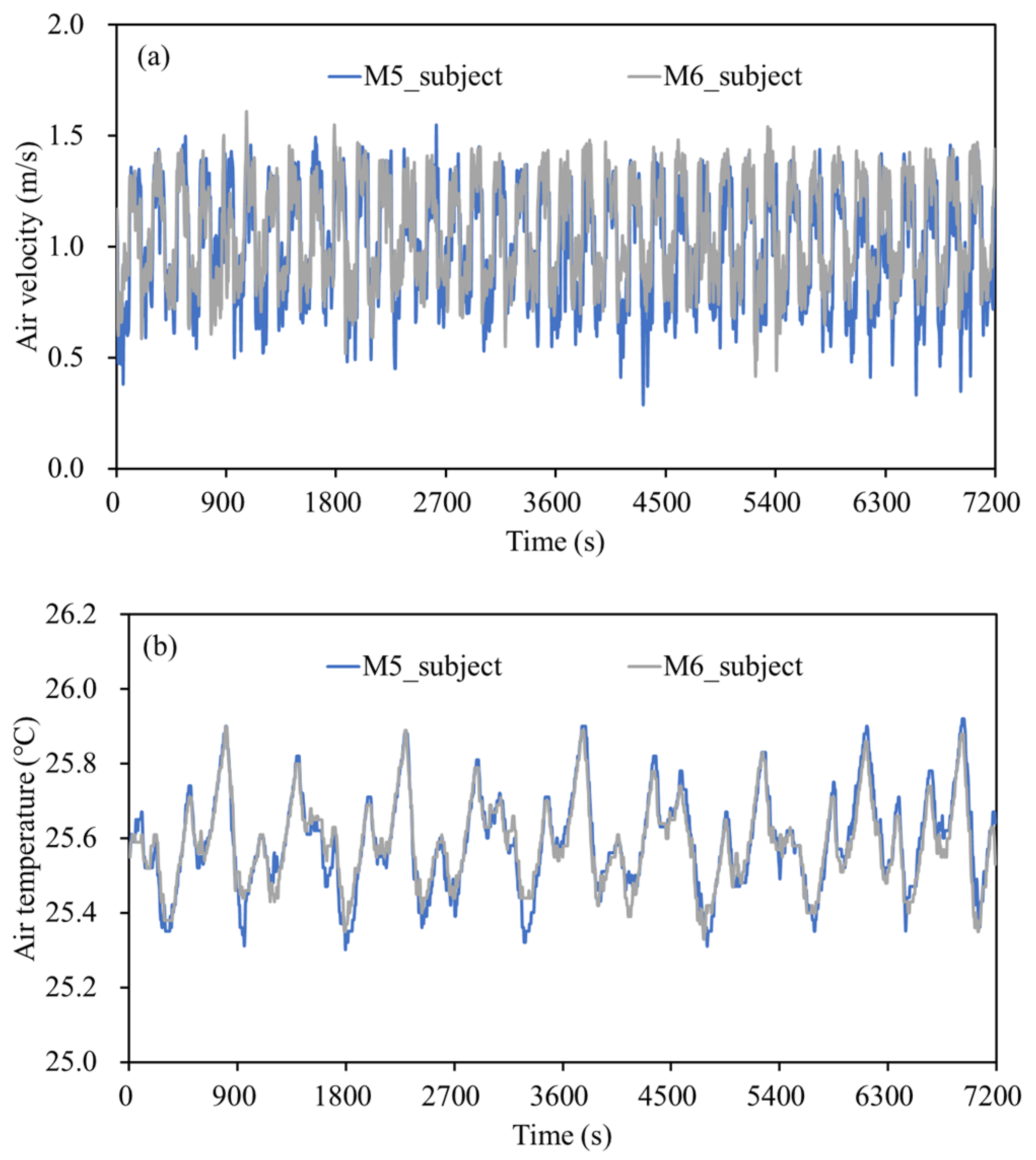
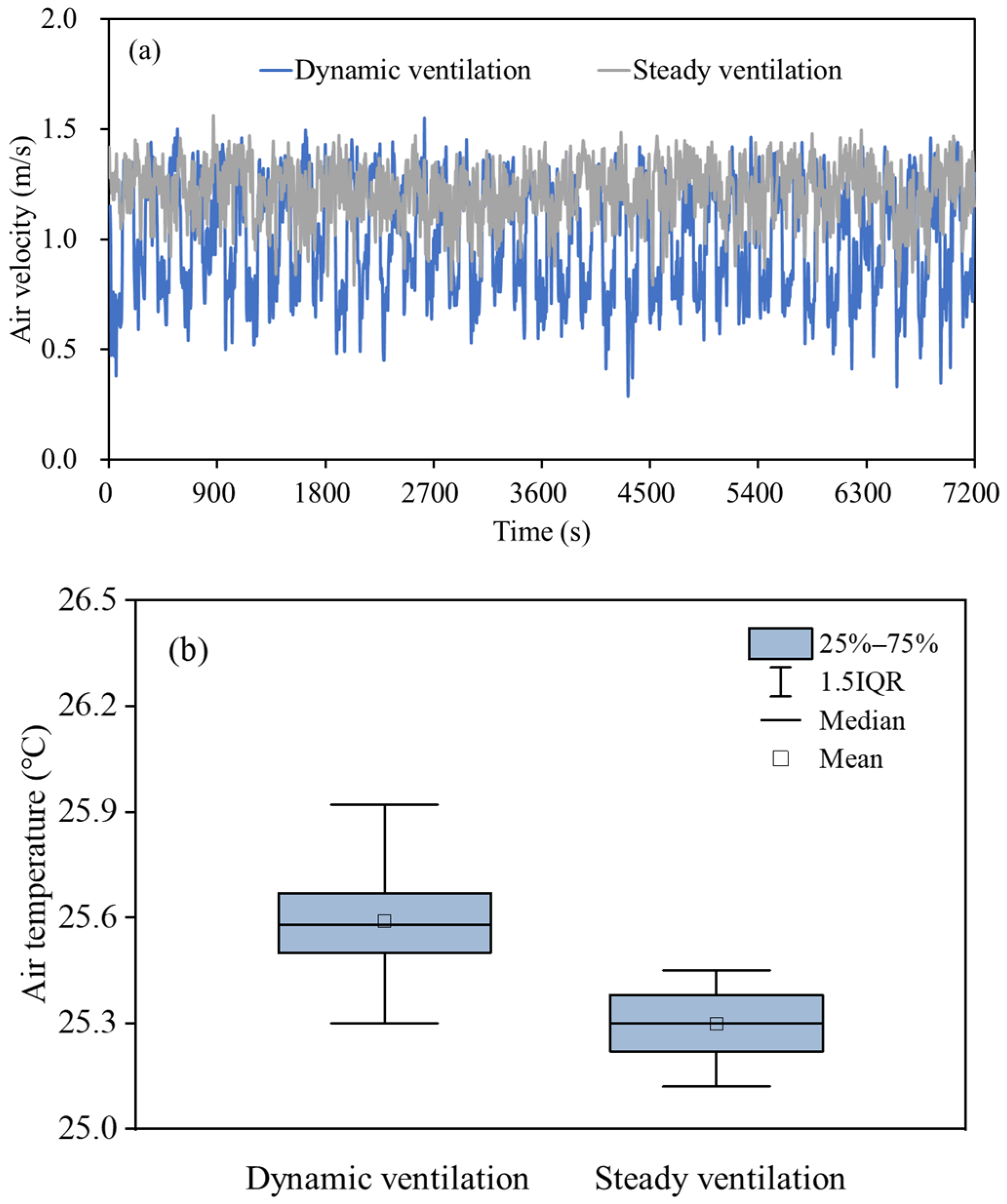

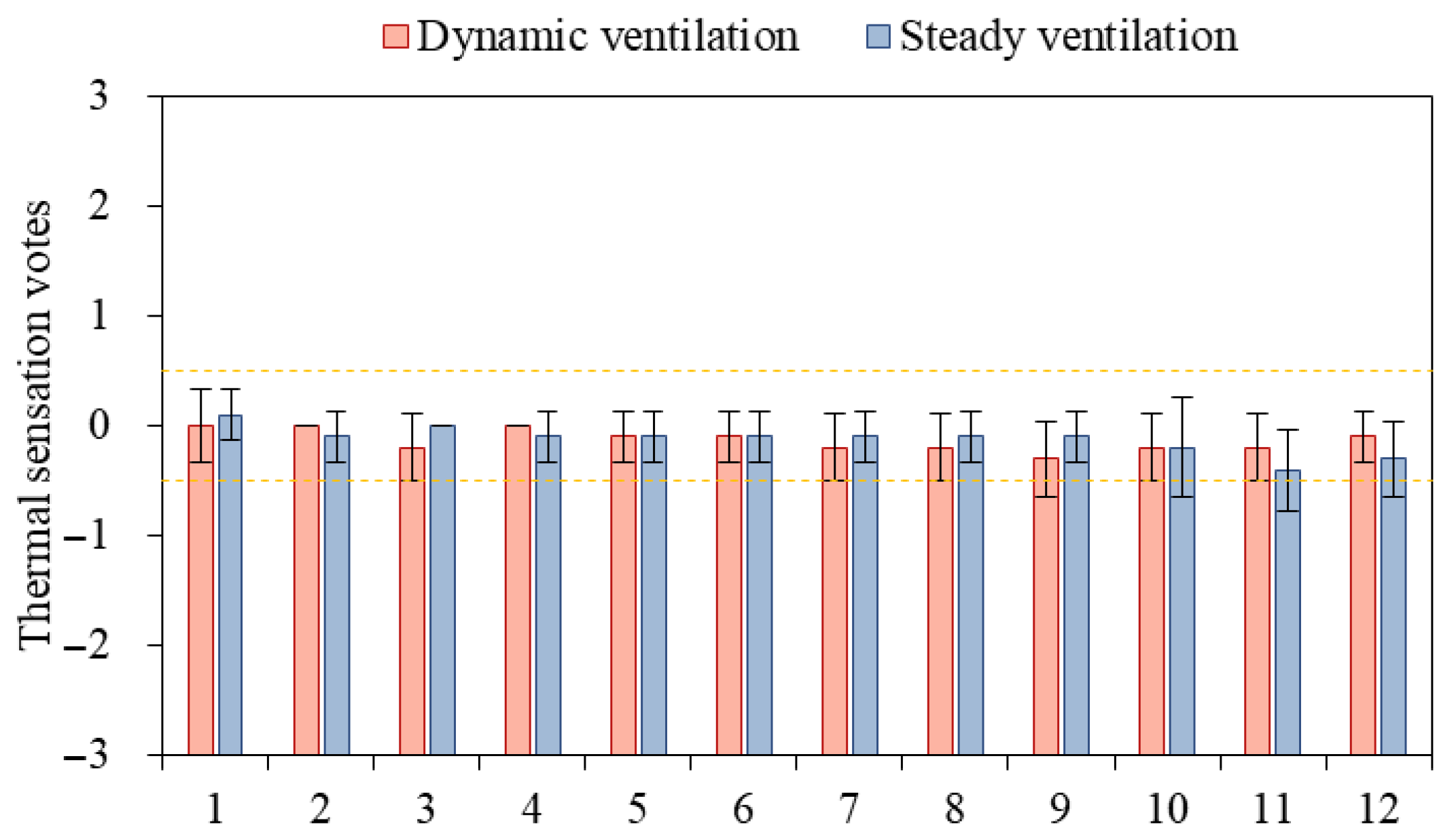
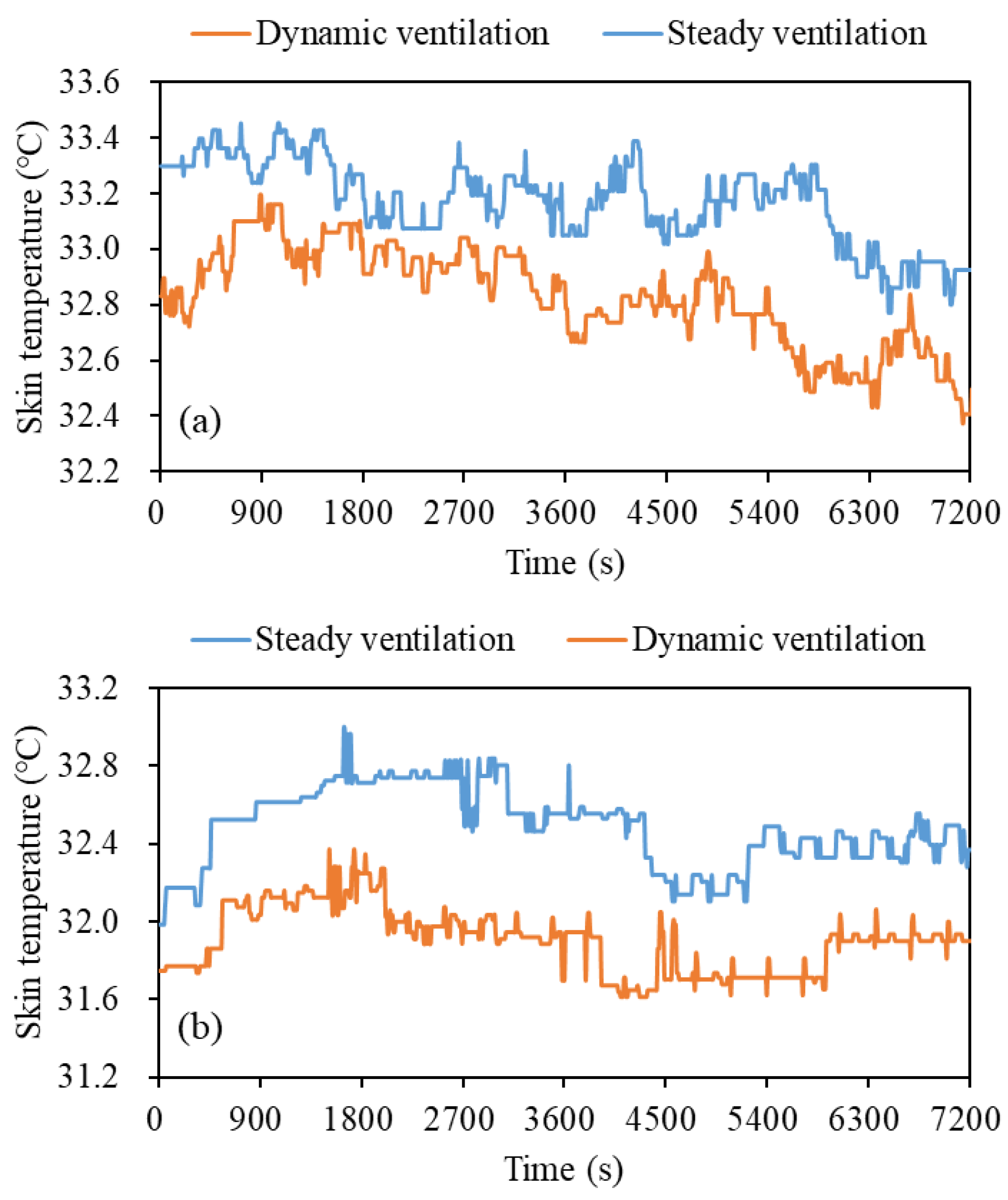
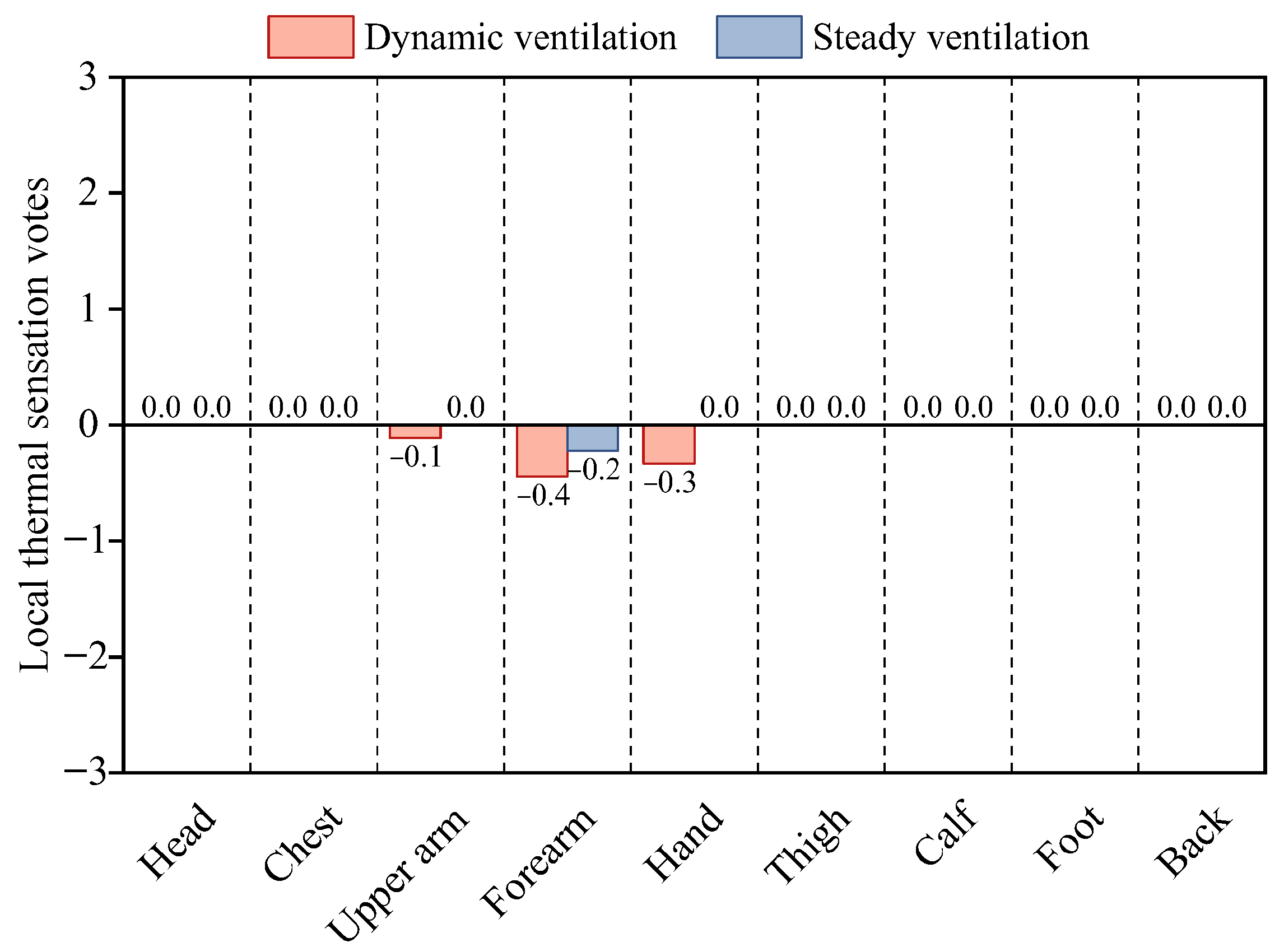
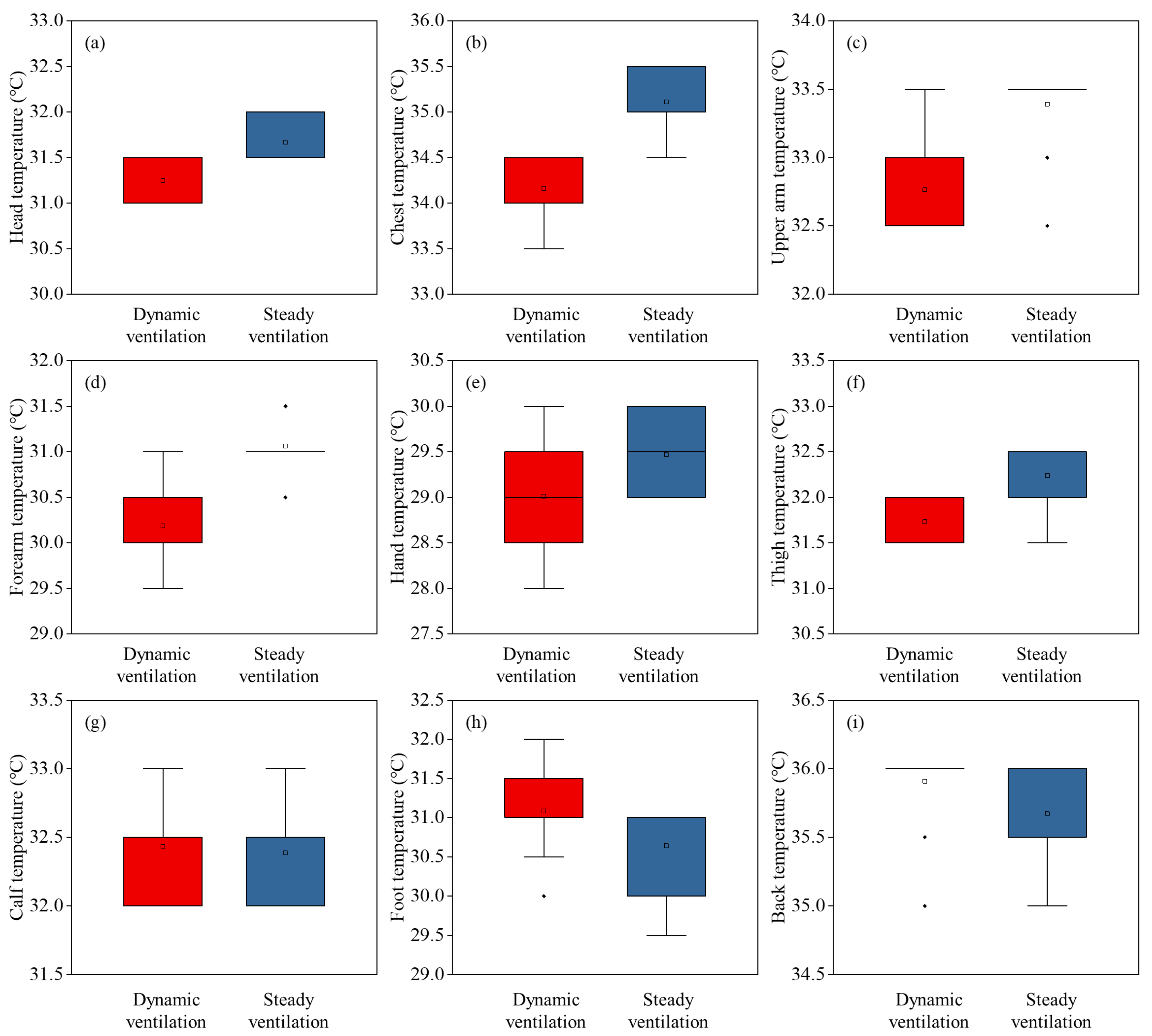

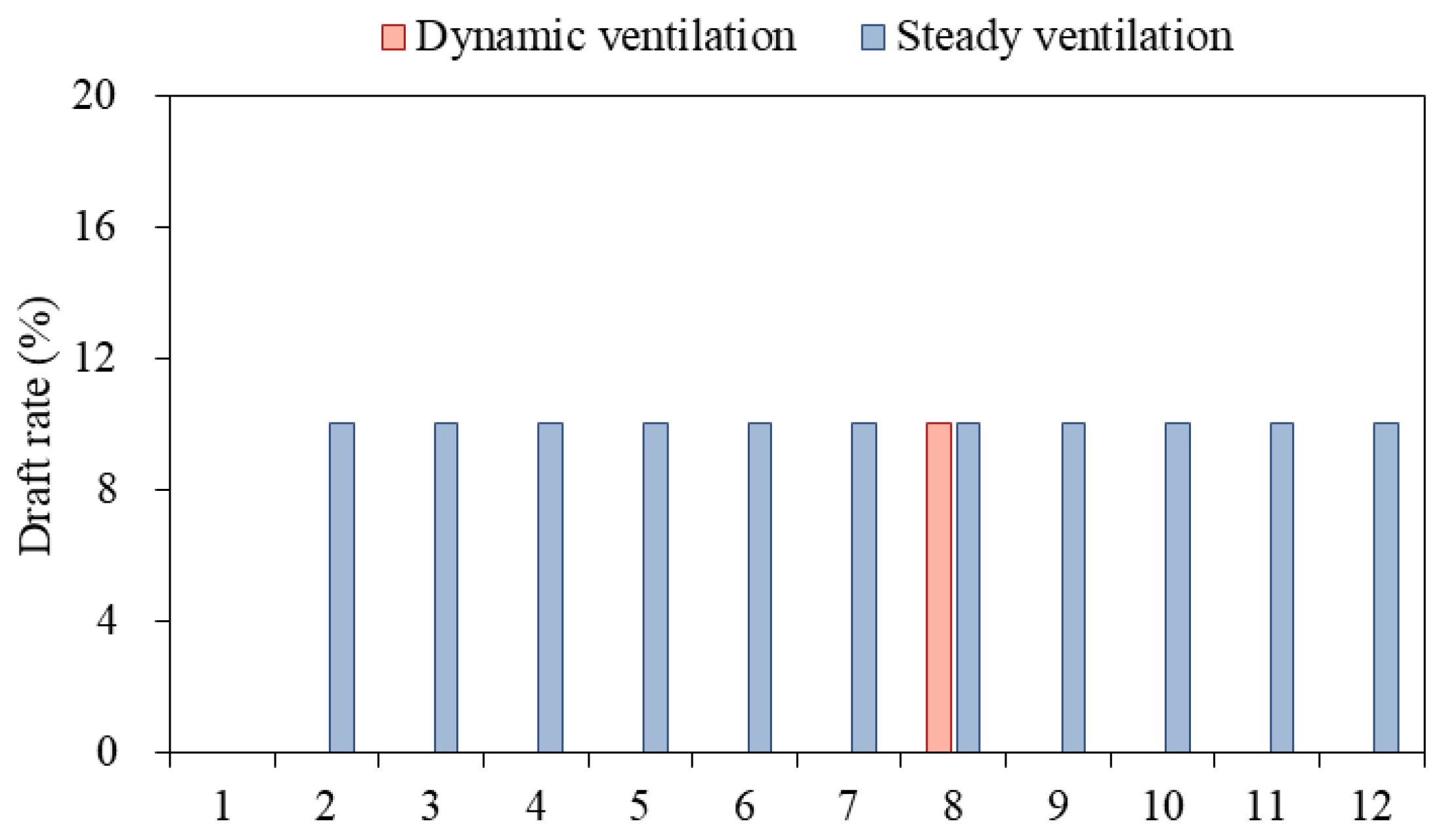
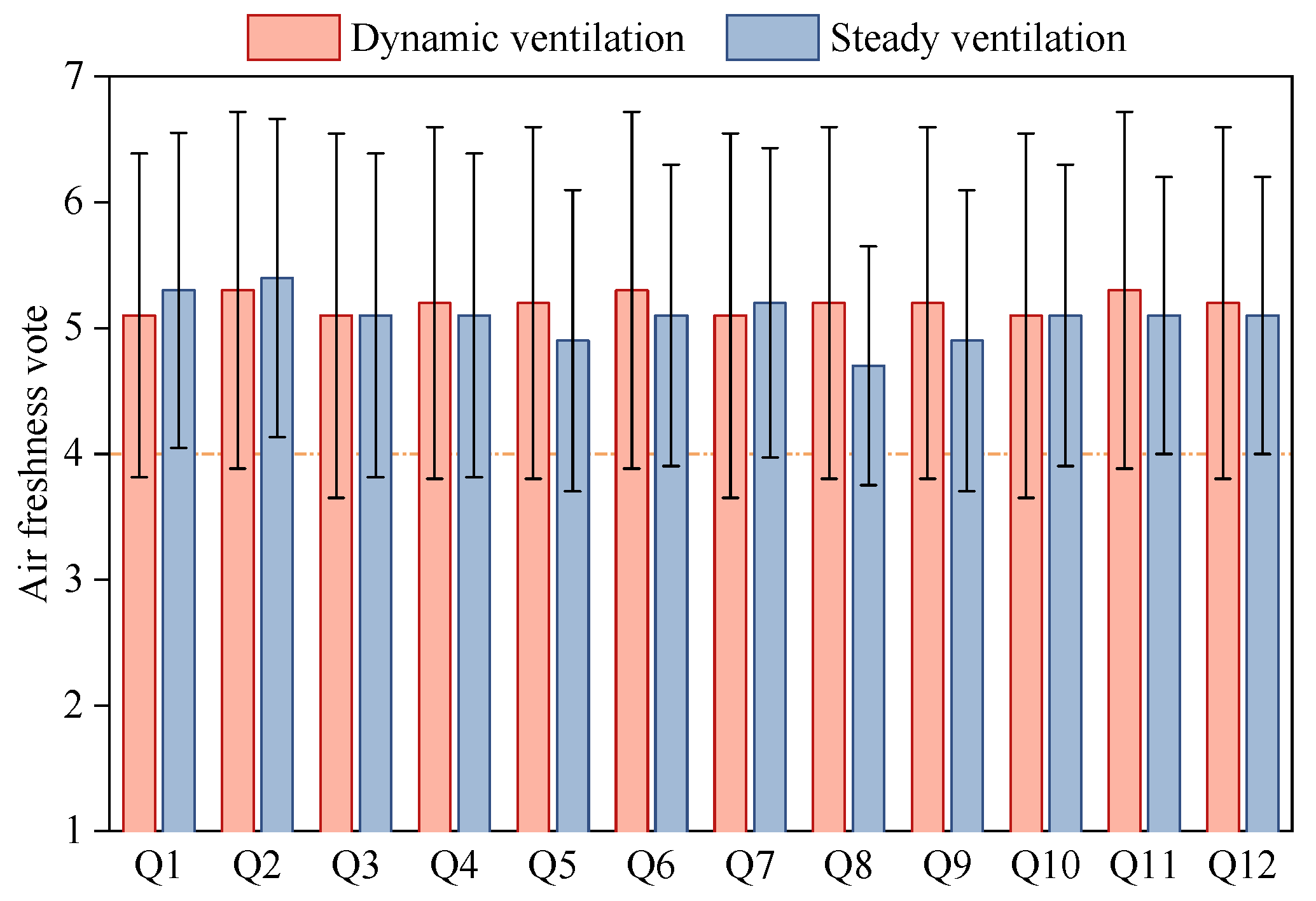

| Instruments | Parameter | Location | Height | Range | Accuracy |
|---|---|---|---|---|---|
| WWFWZY-1 | Air temperature Air velocity | M1–M6 | 1.3 m (M1–M2) 0.1 m (M3–M4) 1.1 m (M5–M6) | −20–80 °C 0.05–30 m/s | ±0.5 °C ±0.05 m/s |
| WWSZY-1 | Air temperature Relative humidity | M1–M2 | 0.2 m (M1–M2) | −40–100 °C 0–100% | ±0.3 °C ±3% |
| WHQZY-1 | Global temperature | M7 | 1.1 m (M7) | −20–80 °C | ±0.3 °C |
| DS1922L-F5# iButton sensors | Skin temperature | - | - | −40–85 °C | ±0.5 °C |
| Gender | Age (Years) | Height (cm) | Weight (kg) |
|---|---|---|---|
| Male | 24.6 ± 2.5 | 173.83 ± 2.94 | 77.65 ± 8.83 |
| Female | 24.0 ± 1.0 | 163.94 ± 7.57 | 54.37 ± 7.03 |
Disclaimer/Publisher’s Note: The statements, opinions and data contained in all publications are solely those of the individual author(s) and contributor(s) and not of MDPI and/or the editor(s). MDPI and/or the editor(s) disclaim responsibility for any injury to people or property resulting from any ideas, methods, instructions or products referred to in the content. |
© 2025 by the authors. Licensee MDPI, Basel, Switzerland. This article is an open access article distributed under the terms and conditions of the Creative Commons Attribution (CC BY) license (https://creativecommons.org/licenses/by/4.0/).
Share and Cite
Lao, C.; Ling, J.; Li, J.; Jiang, J.; Zhang, S.; Yan, Y.; Yin, Y.; Gu, M. Subjective Perception and Cooling Effect for Dynamic Ventilation with Fluctuating Air Velocity. Buildings 2025, 15, 2871. https://doi.org/10.3390/buildings15162871
Lao C, Ling J, Li J, Jiang J, Zhang S, Yan Y, Yin Y, Gu M. Subjective Perception and Cooling Effect for Dynamic Ventilation with Fluctuating Air Velocity. Buildings. 2025; 15(16):2871. https://doi.org/10.3390/buildings15162871
Chicago/Turabian StyleLao, Chunfeng, Jing Ling, Jing Li, Jinghua Jiang, Sheng Zhang, Yan Yan, Yue Yin, and Mingliang Gu. 2025. "Subjective Perception and Cooling Effect for Dynamic Ventilation with Fluctuating Air Velocity" Buildings 15, no. 16: 2871. https://doi.org/10.3390/buildings15162871
APA StyleLao, C., Ling, J., Li, J., Jiang, J., Zhang, S., Yan, Y., Yin, Y., & Gu, M. (2025). Subjective Perception and Cooling Effect for Dynamic Ventilation with Fluctuating Air Velocity. Buildings, 15(16), 2871. https://doi.org/10.3390/buildings15162871





